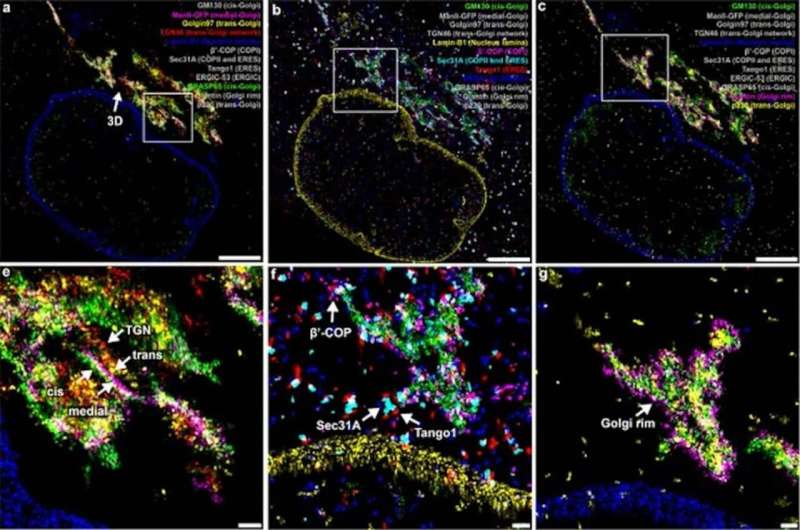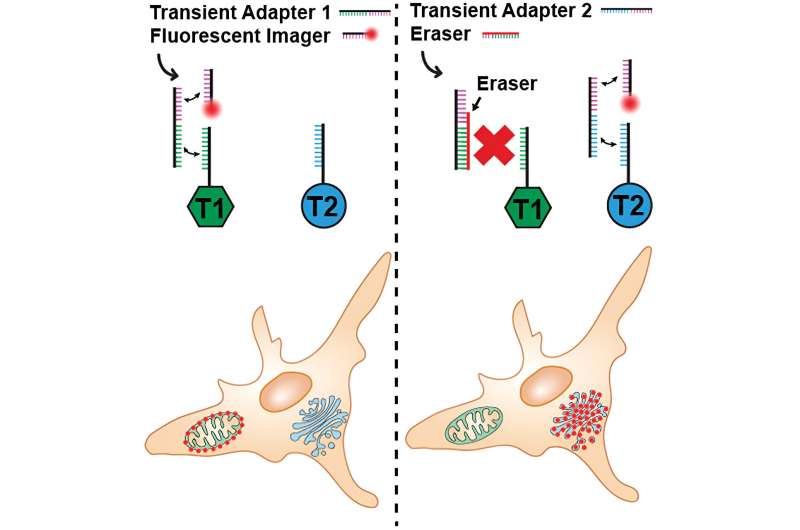This article has been reviewed according to Science X's editorial process and policies. Editors have highlighted the following attributes while ensuring the content's credibility:
fact-checked
peer-reviewed publication
trusted source
proofread
Advanced microscopy technique offers a new look inside cells

Imagine tuning into a football game, but all of the players are invisible except for the two quarterbacks. Without being able to see the orchestrated movements of the full teams, this would be a very confusing game to watch.
Researchers face a similar dilemma when imaging cells under a microscope. Within a single cell lives an intricate ecosystem of millions of molecules interacting with one another. Viewing organelles, proteins, and other tiny subcellular components requires super-resolution microscopy. However, this process currently enables researchers to visualize only a handful of different targets at a time.
A new microscopy technique developed by Yale scientists provides an unprecedented way to view the inner workings of individual cells. The new technique, named FLASH-PAINT, allows researchers to view a potentially unlimited number of different molecules.
At the heart of the process is a novel application of imaging probes, or reagents, which are compounds that are applied to biological specimens to enhance scientists' ability to detect tiny details. The team published their findings in Cell.
"If you are just able to look at one or two proteins, you're missing the big picture," says Joerg Bewersdorf, Ph.D., Harvey and Kate Cushing Professor of Cell Biology and principal investigator of the work. "We can now image as many proteins and other features as we want, in a very elegant and fast manner."

New imaging probe transiently binds to an unlimited number of molecules
A current method for visualizing inner cellular processes involves the use of an antibody in combination with imaging probes consisting of a single strand of DNA and a fluorescent dye. The antibody guides the probe to its target, where the DNA strand binds to a complementary "docking" DNA strand on the antibody.
One limitation of this technique is that each target requires its own imaging probe. For example, if a team wanted to look at 10 different targets, it would need to apply 10 probes. "But if our vision was to image every protein in a cell, there are roughly 20,000 different proteins," says Florian Schüder, Ph.D., associate research scientist in cell biology and the paper's first author. Imaging those cells, he says, has not been feasible with existing technologies.
To overcome this obstacle, the Yale team introduced an adapter that goes between the imaging probe and target. This adapter is highly flexible in its design and can connect any kind of probe with any type of target. Key to the new technique's success is that the adapter binds to the target only very briefly. "It's really crucial that it can switch easily from one target to the next," says Bewersdorf.
Speedy and cost-efficient microscopy paves the way for new discoveries
The new probe's transient binding and ability to connect with numerous targets makes FLASH-PAINT 100 times faster and does so at a fraction of the cost of current super-resolution microscopy techniques. "This will speed up the scientific discovery process," says Bewersdorf. "Instead of doing a hundred experiments looking at individual interactions of one or two proteins, we can now do a single experiment where we can see all possible interactions."
The team hopes that FLASH-PAINT will allow researchers to visualize previously inaccessible complex subcellular processes, which in turn may help clinicians learn how to better treat a range of diseases, including cancers. "There are many players involved in battling disease, and you can only have a full understanding if you actually look at all of them," says Bewersdorf.
In further research, the Yale team is exploring FLASH-PAINT's application in tissue imaging and its potential as a diagnostic tool.
More information: Florian Schueder et al, Unraveling cellular complexity with transient adapters in highly multiplexed super-resolution imaging, Cell (2024). DOI: 10.1016/j.cell.2024.02.033
Journal information: Cell
Provided by Yale University


















